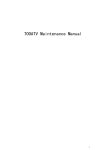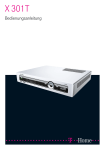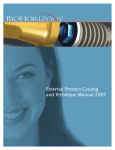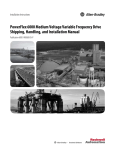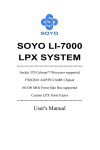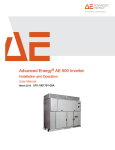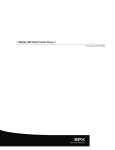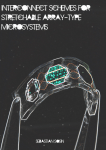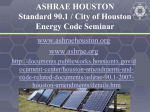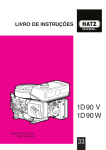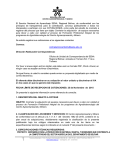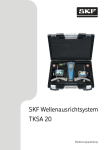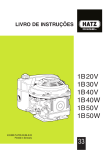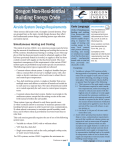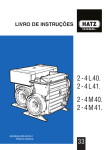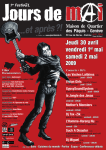Download Display - Service, Support
Transcript
Operating Instructions H – R 258 en 12.04 Three–phase motors with squirrel cage for high voltage, with sleeve bearings AHTA-355..–.. to 560..-.. AHQA-630..–.. to 800..-.. AHXA-355..–.. to 560..-.. JHTA–315..-.. to 800..-.. JHQA–500..-.. to 800..-.. JHXA–355..-.. to 800..-.. LOHER GmbH P.O. Box 1164 • 94095 RUHSTORF Hans–Loher–Str. 32 • 94099 RUHSTORF GERMANY Phone +49 8531 39–0 • Fax +49 8531 32895 E–Mail: [email protected] http://www.loher.de Table of contents Page 1. Safety and commissioning instructions. . . . . . . . . . . . . . . . . . . . . . . . . . . 2 2. Description . . . . . . . . . . . . . . . . . . . . . . . . . . . . . . . . . . . . . . . . . . . . . . . . . . . 5 3. Transport . . . . . . . . . . . . . . . . . . . . . . . . . . . . . . . . . . . . . . . . . . . . . . . . . . . . 7 4. Installation and commissioning . . . . . . . . . . . . . . . . . . . . . . . . . . . . . . . . . . . 8 5. Maintenance . . . . . . . . . . . . . . . . . . . . . . . . . . . . . . . . . . . . . . . . . . . . . . . . . .15 6. Additional equipment . . . . . . . . . . . . . . . . . . . . . . . . . . . . . . . . . . . . . . . . . . . 19 7. Spare parts. . . . . . . . . . . . . . . . . . . . . . . . . . . . . . . . . . . . . . . . . . . . . . . . . . 19 8. Storage instructions . . . . . . . . . . . . . . . . . . . . . . . . . . . . . . . . . . . . . . . . . . . . 20 9. Faults and remedies . . . . . . . . . . . . . . . . . . . . . . . . . . . . . . . . . . . . . . . . . . . 24 Appendix 1; Alignment check . . . . . . . . . . . . . . . . . . . . . . . . . . . . . . . . . . . . 25 Subject to modifications Loher GmbH 2004 All rights reserved H–R 258 en 12.04 Page 1 of 25 Safety and commissioning instructions 1. Safety and commissioning instructions 1.1 Safety symbols in these instructions The symbols are used in this user manual in order to draw attention to special dangers. This symbol indicates a dangerous situation. Fatal or serious injuries or larger material damage can result. Danger This symbol shows a situation that may be dangerous. If not avoided, injuries or material damage may result. 1.2 General Danger 1.3 High–voltage machines rated at more than 1 kV have dangerous live and rotating parts and may have hot surfaces. All operations serving transport, connection, putting into service and maintenance shall be carried out by responsible skilled persons (in conformity with EN 50 110–1 / DIN / VDE 0105; IEC 60364). Improper handling may cause serious personal injury and damage to property. Danger! Intended use These high–voltage machines are intended for industrial installations. They comply with the harmonized standards of the series EN 60034 / DIN VDE 0530. Their use in hazardous areas is prohibited unless they are expressly designed for such use (follow supplementary instructions). On no account, use degrees of protection ≤ IP 23 outdoors. Air–cooled models are designed for ambient temperatures of –20°C up to 40°C and altitudes of ≤ 1000 m above sea level. Ambient temperature for air–/water–cooled models should be not less than +5°C (for sleeve–bearing machines, see manufacturer’s documentation). By all means, take note of deviating information on rating plate. Field conditions must conform to all rating plate particulars. High–voltage machines are components for installation in machinery within the meaning of the Machinery Directive 98/37/EC. Putting into service is prohibited until conformity of the end product with this directive has been established (follow particular local safety and installation rules as e.g. EN 60204). 1.4 Transport, Storage Immediately report damage established after delivery to transport company. If appropriate, prevent putting into service of machine. Eyebolts are dimensioned for the weight of the high–voltage machine, do not apply additional loads. If necessary, use suitable, adequately dimensioned means of transport (e.g. rope guides). Remove shipping brace (e.g. antifriction or sleeve bearing locks, vibration dampers) before putting machine into service. Reuse it for further transports. When storing high–voltage machines, make sure of dry, dust–free and low–vibration (Vrms ≤ 0.2 mm/s) location (danger of bearing damage at rest). Measure insulation resistance before putting machine into service. With values of v 4⋅(UN [kV]+1) [MΩ] at 20°C winding temperature, dry the winding. Refer to the section ”Storage regulations”. Page 2 of 25 H–R 258 en 12.04 Safety and commissioning instructions 1.5 Danger Installation Make sure of even support, solid foot or flange mounting and exact alignment in case of direct coupling. Avoid resonances with rotational frequency and double mains frequency as a result of assembly. Turn rotor, listen for abnormal slip noises.Check direction of rotation in uncoupled state (refer to the section ”Electrical connection”). Mount or remove couplings or other drive elements only with appropriate means (heat!) and cover them with touch guard. Avoid excessive radial and axial bearing loads (note manufacturer’s documentation). The balance of the high–voltage machine is indicated (H = Half, F = Full key). With half–key models, the coupling, too, must be half–key balanced. In case of protruding, visible part of key, establish mechanical balance. Make necessary ventilating pipe connections. Models with shaft ends pointing upward to be provided with cover by customer. The ventilation must not be obstructed and the exhaust air, also of neighbouring sets, not taken in directly. 1.6 Electrical connection All operations must be carried out only by skilled persons on the high–voltage machine at rest. Before starting work, the following five safety rules must be strictly applied: Danger – De–energize! – Provide safeguard against reclosing! – Verify safe isolation from supply! – Connect to earth and short! – Cover or provide barriers against neighbouring live parts! De–energize auxiliary circuits (e.g. anti–condensation heating). Exceeding of limit values of zone A in EN 60034–1/DIN VDE 0530–1 – voltage ± 5%, frequency ± 2%, form and symmetry – leads to higher temperature rise. Note rating plate particulars and connection diagram in terminal box. The connection must be so made that permanently safe electrical continuity is maintained. Use appropriate cable terminations. Establish and maintain safe equipotential bonding. The clearances between uninsulated, live parts and between such parts and earth must not be below the following values: 36 mm at UN ≤ 3.3 kV, 60 mm at UN ≤ 6.6 kV, 100 mm at UN ≤ 11 kV. No presence of foreign bodies, dirt or moisture is allowed in the terminal box. Close unused cable entrance holes and the box itself in a dust– and watertight manner. For trial run without output elements, lock fitting key. For high–voltage machines with accessories, check satisfactory functioning of these before putting into service. he proper installation (e.g segregation of signal and power lines, screened cables etc.) lies within the installer’s responsibility. If no further information is given, the torque for the contact screws and nuts should be used according to section 4.9.2. H–R 258 en 12.04 Page 3 of 25 Safety and commissioning instructions 1.7 Operation Danger Vibration severities in the ”satisfactory” range (Vrms ≤ 4.5 mm/s) according to ISO 3945 are acceptable in coupled–mode operation. In case of deviations from normal operation – e.g elevated temperature, noises, vibrations – disconnect machine, if in doubt. Establish cause, consult manufacturer, if necessary. Do not defeat protective devices, not even in trial run. In case of heavy dirt deposits, clean cooling system at regular intervals. From time to time, open closed condensate drain holes, if any. In case of sleeve–bearing machines, observe time–limit for oil–change. Refer to manufacturer’s documentation for sound power level and information about the use of appropriate sound–reducing measures. 1.8 Maintenance and servicing Follow manufacturer’s operating instructions. Page 4 of 25 H–R 258 en 12.04 Description 2. 2.1 Description Overall construction and design Mounting arrangement acc. to EN 60034–7: Horizontal arrangement IM B3 Vertical arrangement IM V1 or IM V10 see dimension drawing or rating plate Connection designations acc. to DIN VDE 530 part 8 IEC 60034 – 8: see wiring diagram Degree of protection acc. to EN 60034 – 5: see rating plate Cooling acc. to EN 60034–6: IC 411 surface cooling or hollow–fin cooling IC 511 tube cooling IC 01 internal cooling IC 611 internal cooling with mounted–on air–to–air heat exchanger IC 81 W internal cooling with air–water heat exchanger IC 71 W water jacket cooling Details of the motor design are indicated in the relevant technical catalogues. 2.2 Bearings The motors are equipped with sleeve bearings. The bearings are provided with oil-ring lubrication (with natural cooling) or with circulating oil lubrication (external oil cooling) or water cooling. The rotor has axial play. The axial play is indicated in the dimension drawing and marked on the motor. The additional operating instructions “Axial Play Indicator” must be observed. It is not permissible that axial forces from the coupling or from the working machine are transmitted to the motor bearings. (Special bearings for taking up axial forces will only be provided if specially ordered). 2.3 Cooling 2.3.1 Surface cooling (TEFC) for the Type AHTA–... / AHQA–... Design for fin–, hollow–fin– or tube cooling, where an external fan takes in the cooling air through the openings in the fan cover and presses the air over the surface or through the cooling tubes of the stator housing. In case of hollow–fin or tube cooling the heat dissipation is supported by a closed cooling air circuit inside the motor. 2.3.2 Internal cooling for the Type JHTA–... In case of motors with method of protection IP 23, the cooling air (ambient air) is taken in by internal fans through air inlet openings, led over the heat–generating elements in the motor and blown out through air outlets. 2.3.3 Internal cooling with mounted–on air–water heat exchanger for the Type JHXA–... The motors are equipped with air–water circuit coolers. The cooling air led through the heat exchanger and motor is recooled in the heat exchanger and the heat loss is dissipated through the cooling water. The heat exchangers are provided with special ribbed tubes. 2.3.4 Internal cooling with mounted–on air–to–air heat exchanger for the Type JHQA–... The motors are equipped with an air–to–air heat exchanger. The cooling air led through the heat exchanger and motor is recooled in the heat exchanger and the heat loss is dissipated through air as the cooling medium. 2.3.5 Water jacket cooling for the Type AHXA–355..–.. to AHXA–560..–.. The stator housing has a double casing. It is sub–divided by spirals for water channelling and the cooling water passes through it. This results in a good heat dissipation. Additionally, this reduces the danger of suspended matters carried along in the water getting deposited. H–R 258 en 12.04 Page 5 of 25 Description 2.4 Motor frame 2.4.1 Construction for surface cooling (TEFC), hollow–fin cooling or tube cooling (Type AHTA–...–.. / AHQA–...) Depending on the frame size the stator frame and end shields are made of grey cast iron or steel. The fan cover is made of sheet steel. The stator frame surface is provided with cooling fins, hollow fins or tubes and an attached terminal box. 2.4.2 Construction for internal cooling (ODP) for the Type JHTA–... Depending on the frame size the stator frame and end shields are made of cast iron or steel. The stator frame has an even surface with an attached terminal box. There are spacer fins between stator jacket and stator pack to facilitate internal cooling. 2.4.3 Construction for internal cooling with air–water heat exchanger for the Type JHXA–... The stator frame and end shields are of steel. The stator frame surface is plain with mounted–on terminal box. Between the stator jacket and the stator core there are spacing ribs to facilitate the internal cooling. An air–water circuit cooler is mounted on the ventilation openings. 2.4.4 Construction for internal cooling with air–to–air heat exchanger for the Type JHQA–... Like for the internal cooling with air–water heat exchanger, however, an air–to–air heat exchanger is mounted onto the ventilation openings. 2.4.5 Construction for water jacket cooling (Type AHXA–355..–.. to AHXA–560..–..) Stator frame and end shields are made of grey cast iron or steel. The stator jacket is designed as a double casing, through which the cooling water is led. The housing is provided with an inlet and outlet for the cooling water. 2.5 Stator winding The stator winding is made in an insulation class (see rating plate) acc. to EN 60034–1. High–quality winding wires, suitable surface insulating materials and the type of impregnation provide a high level of mechanical and electrical stability with a high utilization factor and a long service life. 2.6 Rotor The rotor has a hard–soldered cage. The rotor is dynamically balanced. The balance is indicated on the shaft end or the rating plate, see Paragraph 4.1 ”Installation”. The motors in standard design meet the requirements of vibration level N acc. to DIN EN 60034–14 / IEC 60034–14, in special cases level R (reduced) or S (special). 2.7 Terminal boxes Apart from the motor connector boxes, additional connection, boxes for monitoring equipment are available if required.. A neutral point box is only attached if ordered as an extra (see dimensional drawing). The number of available terminals can be seen in the wiring diagrams. 2.8 Monitoring devices Monitoring devices are only available if specially ordered. See the wiring diagram. Page 6 of 25 H–R 258 en 12.04 Transport 3. Transport For handling during transport, the stator construction of the motor is equipped with lifting lugs, to which the lifting hooks can be fixed. Check whether the screwed lifting lugs are securely tightened. Lift motors only by using these lifting lugs. Several lifting lugs must always be used together. Lifting the motors from other parts (e.g. shaft ends) is not permitted, since this might result in considerable damage. The lifting lugs are only suitable for the motor weight. Additional loads attached to the motor must never be lifted using these lugs. 3.1 Check before installation Check whether the motor has been damaged during transport. If the packing is damaged to such an extent that motor damage is to be assumed, the packing should be removed in the presence of a representative of the carrier. 3.2 Bearing lock (for motors with cylindrical roller bearings only.) The rotor of the motor is axially locked by a securing device for transport that is fixed on the shaft end or on the mounted coupling, braced against the bearing body. Before the motor is commissionined, the securing device must be removed. Thereafter, it must be possible to easily rotate the shaft. The transport locking mechanism must be reused for further transports. Prevent failures and thus avoid damage to persons and property. The person responsible for the installation has to make sure, that – safety instructions and operating instructions are available and observed – the operating conditions and technical data acc. to the order are observed – protective equipment is used – the specified maintenance work is carried out. H–R 258 en 12.04 Page 7 of 25 Installation and commissioning 4. Installation and commissioning A most careful mounting and alignment of the motors on an absolutely even surface is imperative to avoid distortions when the screws are being tightened. For machines which are to be coupled, attention must be paid to careful alignment. See Appendix 1 for alignment checking. Couplings that are as elastic as possible should be used. When using pulleys, gear wheels etc., ensure that the permitted radial and axial shaft loads are not exeecced. Motors with surface cooling (TEFC), hollow–fin cooling or tube cooling , internal cooling or internal cooling with air–to–air heat exchanger (for all specified types except Type AHXA–... and JHXA–...) The maximum permissible coolant temperature (ambient temperature at installation site) acc. to EN 60034–1/IEC 60034–1 is 40°C (104°F) and a permissible altitude up to 1000 m above mean sea level (other values see rating plate). Care must be taken that the cooling air can flow unhindered into the air inlet openings and freely pass through the air outlet openings and cannot be directly sucked in again. Suction and outlet openings must be protected from obstructions and coarse dust. The motors with water jacket cooling (Type AHXA–355..–.. to AHXA–560..–..) Before commissioning the water–cooled motors, the trouble–free working of the cooling–water circuit must be ensured. It must be ensured that the motor will only be switched on when the cooling– water circuit is in operation. The circuit must be kept in operation until the motor comes to standstill after it is switched off. The inlet and outlet openings are located on the motor housing. The cooling water circuit is to be monitored. Normally, the motor is equipped with PTC thermistor sensors, which switch off the motor if the cooling–water circuit fails. If the housing is provided with vent plugs for the water chamber, venting should be done for the first filling and thereafter at regular intervals. Only clean, non–aggressive cooling water must be used. The permissible content of suspended solids is max. 10mg/l The inlet temperature of the cooling water should be at least 20 °C (68 °F). Temperatures below 20 °C (68 °F) result in higher formation of condensation water and motor failure. The permissible inlet and outlet temperature, maximum pressure and the required amount of cooling water are indicated on the motor plates. If the motors are only allowed to operate at a coolant temperature below 0 °C (32 °F) then, because of the reduced cooling action owing to the addition of antifreeze consultation with the motor manufacturer is necessary. The motors with mounted–on air–water heat exchanger for the Type JHXA–.. Before commissioning the motors, the trouble-free working of the cooling–water circuit must be ensured. It must also be ensured that the motor will only get switched on if the cooling–water circuit is in operation. The cooling water circuit must be kept working until the motor comes to standstill after it has been switched off. The permissible inlet and outlet temperature, maximum pressure and the required amount of cooling water are indicated on the motor plates. Page 8 of 25 H–R 258 en 12.04 Installation and commissioning 4.1 Mounting Fitting of pulleys or couplings. First the shaft end should be cleaned (not with emery cloth) and then greased. The Pulley or coupling should be fitted only with the aid of a fitting device. The threaded centering hole in the shaft end can be used for this purpose.. Insert a threaded bolt into the threaded hole. Then put into place the steel washer, the diameter of which is large enough to cover the hub borehole of the pulley or coupling. Then fit the pulley and coupling onto the shaft end by means of a nut or a suitable hydraulic device. The fitting of the drive elements by means of hammer blows is not permitted because of the risk of bearing damage. When replacing the bearings they must only be removed and reinstalled by means of suitable devices using the shaft centering. Only original spare parts must be used. The rotor of the motor is dynamically balanced. The balance state is indicated on the shaft end face or the rating plate (H = half key, F = full key). Take care of the balance for installation of the driving element! The balancing of the transmission elements to be fitted must be adapted to the rotor balancing. In case of half key balancing, any protruding and visible part of the key must be removed. The motor must only be mounted and operated according to the specified mounting arrangement (see rating plate). 4.2 Connection, insulation resistance Connection must only be made by an expert and in accordance with the valid safety regulations. The relevant installation– and operating instructions as well as national and international rules must be observed. Note the data on the rating plate! Compare the type of current, mains voltage and frequency (refer to item 4.3.1)! Check the wiring diagram! Observe the rated current for setting the protective switch! Connect the motor in accordance with the wiring diagram provided in the terminal box! The motor must be protected against excessive heating. For earthing the motor is provided with an earthing terminal, which depending on the mounting arrangement is either located on the frame or on the flange end shield as the case may be. In addition all motors have a protective conductor terminal inside the terminal box. H–R 258 en 12.04 Page 9 of 25 Installation and commissioning As protection against dust and humidity unused cable entries in the terminal box must have a torsionproof seal. All terminal screws and nuts have to be securely tightened to avoid excessive transition resistances (see paragraph 4.9.2). Protective measures are to be taken. In case of terminal boxes that have ground surfaces between the cover and the base a thin grease film is to be applied for sealing and against corrosion. High-voltage terminal boxes have a pressure-relief valve with predetermined breaking joint (in the bottom part of the terminal box). The valve and sealing must not be damaged during the installation. The method of protection must be guaranteed. In case of damage the sealing must be renewed only with original sealing material. During operation the terminal box must always be tightly closed. The cable entries, lead entries and connecting cables must be suitable for the ambient temperatures that occur. Terminal boxes with current transformer When current transformers are used,. it must be ensured that the secondary circuit of the current transformer is protected from unintentional opening during operation. After storage for a prolonged period or a shutdown (see 8.1.2), the winding must be measured phase to phase and phase to earth before starting up again. Damp windings can result in leakage currents, arc–overs and blow–outs. The insulation resistance for the windings must reach the following values: –Stator winding y 4⋅( Ustator [kV] +1) [MW], measured at a winding temperature of 20°C. Any available overvoltage surpressors that are connected to the motor may falsify the insulation resistance. If there is any doubt, disconnect the overvoltage surpressors. If the insulation resistance is lower, dry the windings (also refer to item 8.1.2). Page 10 of 25 H–R 258 en 12.04 3.2 Installation and commissioning 4.3 Direction or rotation and designation of the terminals acc. to DIN VDE 0530–8/IEC 60034–8 4.3.1 In the case of motors with only one direction of rotation, the direction of rotation is marked on the motor with an arrow. Terminals U1, V1, W1 to phases L1, L2, L3 (in alphabetical or natural order) always results in right–handed rotation. This applies to all motors, even if they are not suited for right–handed rotation. 4.3.2 Changing the direction of rotation: The rotational direction can be switched by exchanging two supply lines on the motor terminal board. For a machine with only one shaft end or two shaft ends with different thicknesses, the direction of rotation is that seen an observer when he views the outer face of the only shaft end or the thicker shaft end. 4.3.3 In case of forced ventilation, the direction of rotation is separately marked by an arrow on the forced ventilation system itself. 4.4 Air–water heat exchanger (motors with air–water heat exchanger of the type JHXA–...) For connection and commissioning the instructions for air–water heat exchangers must be considered. The permissible inlet and outlet temperature, maximum pressure and the required amount of cooling water are indicated on the motor plates. 4.5 Oil supply The diameter of the piping must be chosen in such a way that for the supply line the flow rate does not exceed 1.5 m/s approx.; for the return line the flow rate should not exceed 0.15 m/s. If a gradient of 15° in the return line cannot be realized because of constructional reasons, correspondingly large diameters must be installed in order to avoid a back draft of oil, which could cause overflowing of the bearing. Welded and hot-bent, rusty or internally significantly dirty piping must be pickled before installation. After installation of the piping the whole oil circuit must be flushed in order to avoid bearing damage by contamination. Use kerosene or flushing oil. For this purpose all measuring fittings (pressure switches etc.) must be removed and their connections must be closed. After flushing, the filters must be cleaned. The bearings must never be left in the flushing circuit under any circumstances. For filling the bearing lube oil by collecting units, for example in connection with gears, a corresponding filter must be provided in the pressure pipe to the motor. Further, before every bearing a suitable pressure reducing valve must be provided in the pressure pipe, using which the oil pressure can be adjusted from 0.2 to 0.8 bar (at operating temperature). We recommend installing electronic flow indicators in the discharge lines behind the bearings to be able to check the oil circuit. Flow inspection glasses are provided as a standard feature. H–R 258 en 12.04 Page 11 of 25 3.2 Installation and commissioning 4.6 Sleeve bearings In order to avoid leaking of the oil during transport, the bearings of the motors are delivered without bearing oil from the factory. Prior to commissioning, the bearings must be filled with oil up to the oil level mark and up to the oil return respectively. The viscosity class acc. to DIN 51519 of the bearing lube oil and the oil quality respectively are indicated on an instruction plate at the motor. In general, any branded mineral oil with low foaming property and good ageing stability, which has the specified viscosity can be used as lubricant. If for any reason a lube oil with a viscosity deviating from that specified is to be used, a confirmation from the motor manufacturer is required. In case of greater deviations, the calculations for the bearings must be performed afresh. If synthetic oils are used, attention must be paid to ensure that only PAO (Poly-Alpha-Olefine) oils are used. For all other synthetic oils, it is necessary to consult the motor manufacturer! The use of motors with sleeve bearings is generally permissible from an ambient temperature of = 0 º C, unless special measures have been taken (e.g. bearing heating). The lower limiting temperature is then specified on the rating plate. At lower ambient temperatures, the lubricating oil must have a pour point of at least 10 Kelvin below the ambient temperature. In the case of sleeve bearings that are lubricated with oil circulation, in order to ensure sufficient oil flow in the oil inlet pipes, the inflow temperature of the oil must not drop below + 10 ºC. 4.7 Sleeve bearings for oil-ring lubrication with water cooling See dimension drawing or instruction plate on the motor! Make sure that the motor is only switched on, when the cooling water circuit is operating. It must be kept running till the motor comes to a stillstand after switch-off. Cooling water supply for sleeve bearings In order to achieve an effective cooling of the bearings, the cooling water inlet temperature should be kept as low as possible! The water speed should not exceed 1.5 m/s to avoid damage by cavitation, which occurs particularly in the pipe elbows. The customer should provide the corresonding regulating devices. Unpressurized discharge of the water is required. It must be possible to drain the cooling water circuit. To control the cooling water circuit it is recommended that electronic flow indicators be installed behind the bearings in the discharge lines. The cooling water requirement, max. cooling water inlet temperature, max. cooling water pressure etc. are indicated on the instruction plates at the motor. Page 12 of 25 H–R 258 en 12.04 3.2 Installation and commissioning 4.8 Check before commissioning – Observe data on the rating plate! – Check whether voltage and frequency of the motor comply with the mains data! – Check whether the bearing lock has been removed! See Paragraph 3.2 “Bearing lock”. – Check whether the bearing is properly filled with oil. – Check whether the oil-ring is seated on the shaft in the correct position! – Check whether, for the bearings, the oil circuit for oil lubrication is in operation! – Check whether the rotor is located in the magnetic center! – Check at starting up whether the oil ring is running freely and provides a perfect oil supply for the sleeve bearing! – Check at the bearings for water cooling, whether the cooling water circuit is in operation! – Check whether the direction of rotation is correct! – Check whether the motor is protected as specified in the regulations! – Check whether the electrical connections are securely tightened and whether the monitoring devices are correctly connected and adjusted! – Visual check whether the pressure reduction flap and seal in the high voltage terminal box is intact. – Check whether protective measures have been taken: earthing! – Check coolant temperature! – Check whether additional equipment – if present – is functioning. – Check whether the cooling air inlet openings and cooling surfaces are clean! – If a condensation water drain hole exists, open the hole for a short time, so that the condensation water that may have accumulated can be drained. – Check the insulation resistance of the stator winding! – Check whether the motor is securely fixed! – In case of a belt drive, check the belt tension! – Check whether the cover of the terminal box is closed and whether the cable entrances are properly sealed. – In cade of water-cooled motors, check whether the cooling water circuit is in operation! – For motors with forced ventilation, check whether the forced ventilation is functioning and in operation when the main motor is switched on. H–R 258 en 12.04 Page 13 of 25 Installation and commissioning 4.9 Tightening torques for screwed joints 4.9.1 General If no other data is indicated, the following torque limits (screw and nut) are applicable to threaded joints. Note: 4.9.2 Screwed joints for electrical connections Thread 4.9.3 Screws which become unusable have to be replaced by new ones of the same strength class and type. Tightening torque [Nm] Thread Tightening torque [Nm] M4 1.2 M 12 15.5 M5 2 M 16 30 M6 3 M 20 52 M8 6 M 24 80 M10 10 M 30 150 Screwed joints strength class 8.8 and A4–70 Tightening torques for screws of the strength class 8.8 and A4–70 (A4–80) only in components with higher strength (e.g. grey cast iron, steel). Thread 4.9.4 Tightening torque [Nm] Thread Tightening torque [Nm] M4 2.3 M 14 105 M5 4.6 M 16 160 M6 7.9 M 20 330 M8 19 M 24 560 M10 38 M 30 1100 M 12 66 M 36 1900 Screwed joints strength class 5.6 Tightening torques for screws of the strength class 5.6, 4.6, A2 or for screws in components with lower strength (e.g. aluminium). Thread Page 14 of 25 Tightening torque [Nm] Thread Tightening torque [Nm] M4 1.1 M 14 49 M5 2.1 M 16 75 M6 3.7 M 20 150 M8 8.9 M 24 260 M10 18 M 30 520 M 12 30 M 36 920 H–R 258 en 12.04 Maintenance 5. Maintenance The person responsible for the facility must ensure that the specified maintenance work is carried out properly. 5.1 Bearings, lubrication and cooling of the bearings The bearings of these motors are constructed in two parts. The bearing shells allow self-adjustment under load. The bearing surfaces are subjected to a precise machining. Rescraping of the surfaces should therefore be strictly avoided under any circumstances. The oil rings are essential for the bearings and require careful treatment. They must be protected against damage and deformations. 5.1.1 Sleeve bearings with oil-ring lubrication (natural cooling) The big ribbed housing surface of the bearings guarantees good cooling. The bearing housings must be kept clean form the outside in order not to affec the heat radiation owing to dust or dirt deposits. Lubrication is done automatically by oil-ring lubrication. The oil rings are absolutely essential for the bearing. Prior to commissioning, the bearings must be filled with oil up to the oil level mark. Commissioning After starting the bearings must be continuously monitored during the first hours, for the following parameters a) Bearing temperature The temperature should rise constantly up to the steady-state temperature. If the steady-state point does not occur below 90 °C (194 °F), the equipment must be stopped and the reasons determined. If operating temperatures have been indicated for the bearings, the reasons have to be found, in case of downward deviations (cold bearings)as well. For example, it is possible that the thermometers are defective. b) Oil leaks The bearings must not lose oil, neither on the lateral bore holes nor at the parting line or the oil levels, screw plugs etc. Check whether unused connection holes are plugged. In case of oilring lubricated bearings an oil loss can quickly result in destruction of the bearing surfaces. c) Running smoothness The running smoothness of an equipment depends on many influencing factors. If uneven running occurs during the commissioning, the equipment must be stopped at once and the cause must be eliminated. H–R 258 en 12.04 Page 15 of 25 Maintenance Check after commissioning – Check whether the motor is running smoothly. – Check whether the oil ring is seated on the shaft and runs freely. Oil change periods The first oil change should be done after 600 – 700 operating hours. Die Ölwechselfristen sind auf einem Hinweisschild am Motor gestempelt. 5.1.2 Plain bearings for oil circulation lubrication (external oil cooling) Bearing cooling is ensured through the oil circulation lubrication. The maintenance of the oil circulation must be monitored by the system. The large–fanned housing surface of the bearings guarantees additional cooling. The bearing housings must be kept clean externally in order not to disturb the heat radiation with dust or dirt deposits. Lubrication is carried out automatically via the loose ring lubrication. The lubrication rings are absolutely essential for the bearing. For commissioning, bearing temperature, oil sealing, running quietness and checking: refer to section 5.1.1 5.1.3 Plain bearings with loose ring lubrication and water–cooling Bearing cooling is guaranteed by the oil circulation lubrication. The maintenance of the oil circulation must be monitored by the system. The large–fanned housing surface of the bearings guarantees additional cooling. The bearing housings must be kept clean externally in order not to hinder the heat radiation with dust or dirt deposits. Lubrication takes place automatically via the loose ring lubrication. The lubrication rings are essential for the bearing. Before commissioning, the bearings must be filled with oil up to the oil level mark. For commissioning, bearing temperature, oil sealing, running quietness and control after commissioning: refer to section 5.1.1 5.2 Bearing insulation short–circuiting If both bearings are insulated, the bearing insulation on the drive end has to be neutralized during operation by attachment of a short–circuiting (jumper) cable. This measure avoids the build-up of a dangerous voltage potential in the rotor. The motor has an instruction plate attached with the following text: “Attention, both bearings insulated. During operation the DE bearing insulation must be short–circuited.” Page 16 of 25 H–R 258 en 12.04 Maintenance 5.3 Checking the bearing insulation The bearing insulation short–circuit may be neutralized by disconnecting the short–circuiting cable only at stillstand. Insulation of the bearings can now be checked. Upon completion of the insulation test, reconnect the short–circuiting cable. 5.4 Venting filters The sleeve bearing on the driven side or, with air outflow dampers, even the drive–side sleeve bearing, have screwed–on venting filters. The venting filters must be subjected to a visual inspection. The visual inspection can be carried out while the machine is running. Danger of accidents! Pay attention to rotating parts. No dirt or dust may be allowed to penetrate into the air pipe of the sleeve bearing. The lubricating oil must not get dirty. Cover the air pipe during the visual inspection. Do not forget! Put the venting filter on again. 5.5 Maintenance of the venting filters A visual inspection of the venting filters is neessary, with normal use, after 1 year and in case of applications with dust and sand pollution, after year. In case of intense dirtying, the venting filter must be replaced with an original spare part. 5.6 Avoiding mechanical damage (bearing damage) All machines must be regularly inspected for mechanical damage. Particular attention must be paid to compliance with the prescribed oil–changing intervals. In case of bearings with external oil supply, the owner/operator must monitor the preservation of the lubrication by suitable means. The plant must be switched off when the permissible temperature is exceeded, but not later than at 100º C. The bearing insulation, if present, must always conform to DIN 31692–4 and must never be bridged (e.g. by a thermometer) or reduced. H–R 258 en 12.04 Page 17 of 25 Maintenance Regular checking of the lubricant level must be carried out, in case of self–lubricating bearings, through the oil level glass or with level monitoring, or, in the case of externally lubricated bearings, by means of a flow monitoring system to be provided by the owner/operator. If the permissible limiting values are exceeded or undershot, the machine must be switched off without delay. In case of circulation system lubricated bearings, continuous oil filtering must be provided. The mesh width of the oil filter must not exceed 20 mm. 5.7 Terminal locations, terminals, ventilating passages Depending on the operating conditions, the following should be done at certain intervals cleaning the terminal locations and terminals – checking the electrical connections with regard to firm seating (see Paragraph 4.9.2 for tightening torques). – cleaning the cooling air passages. The cooling air inlets and the cooling surfaces must be protected against obstruction and contamination. – If required, the water chambers must be flushed and cleaned of deposits. Never use sharp–edged tools for cleaning. 5.8 Air–water heat exchanger (Motors with air–water heat exchangers of the type JHXA–...) For maintenance, please consider the instructions for the air–water heat exchangers. 5.9 Condensation water drain hole If the motor has a condensation water drain hole, it has to be opened at regular intervals to have the accumulated condensation water can drain off. Care must be taken to seal the condensation water drain hole by a screw with lock washer to ensure the method of protection. Page 18 of 25 H–R 258 en 12.04 4.2 Additional equipment 6. Additional equipment On special order only. 6.1 Temperature monitoring *) The temperature sensors for monitoring e.g. the stator winding temperature, the bearings, the coolant must be connected by one or several additional terminal boxes. The temperature sensors have to be connected according to the relevant connection diagram. The specifications and instructions acc. to Paragraph 4.2 ”Connection” are applicable to the connection. 6.2 Space heater *) Heating capacity and connection voltage: See instruction plate on the motor. The space heater has to be connected by an additional terminal box according to the relevant connection diagram. The specifications and instructions according to Paragraph 4.2 “Connection” are applicable to the connection. Operation of the space heater is only allowed when the motor is switched off. The space heater must never be switched on during motor operation. 6.3 Forced ventilation *) Observe direction of rotation! (see arrow for direction of rotation.) Forced ventilation must be connected according to the wiring diagram inside the terminal box. During operation of the main motor, the forced ventilation motor must be switched on! The forced ventilation dissipates the heat loss during operation of the main motor. When switching off the main motor, the forced ventilation must be continued on a a temperature–dependant basis. 6.3.1 To be checked when commissioning the main motor: Check whether the forced ventilation works and is in operation when the main motor is switched on! *) On special order only 7. Spare parts and components When ordering spare parts, please state: Spare part designation Motor type Motor serial number Example: End shield DE AHTA–450LM–02A 5 134 004 The type and serial number of the motor can be taken from the rating plate. H–R 258 en 12.04 Page 19 of 25 Storage instructions 8. Storage specifications 8.1 For motors which have to be stored for a period of up to 2 years, the following must be observed: 8.1.1 Storage 8.1.1.1 The motors are to be stored dry, dustfree and at room temperature. No special packing is then required. Otherwise the motors must be packed in plastic foil with hygroscopic substances (e.g. Branogel) or sealed in an air–tight foil. Protective cover must be provided against sun and rain. 8.1.1.2 In order to avoid secondary failures at the bearings caused by vibrations at standstill, for example by adjacent running machines, the motors are only allowed to be stored in vibrationless rooms. 8.1.1.3 For transport, motors with sleeve bearings must be equipped with a bearing lock on the drive side. It must remain locked until commissioning or re-installed after an inspection or a trial operation. 8.1.1.4 The motors are delivered and stored without oil filling in the bearings. In order to protect the sleeve bearings incl. the motor shaft against corrosion until commissioning, the following measures must be taken: All the openings must be sealed, the threaded holes must be fitted with plugs, the connection flanges must be fitted with blank flanges, the gap between gasket and shaft or gasket and housing must be covered (self-adhesive, durable tape). Remove the glass cover on the bearing housing; with a pneumatic spraying gun, spray an anti-corrosive through this opening. This medium (e.g. Valvoline Tectyl 511 M) must be such that it does not have to be removed for commissioning the motor. Put a bag with hygroscopic filling (e.g. Branogel) below the glass cover to avoid condensation water being generated. Then, screw down the bearings tight again. If the period of 1/2 year from the date of conservation to the date of commissioning is exceeded, the conservation steps described above must be repeated. Prior to commissioning the hygroscopic fillings must be removed from the bearing housings and the sleeve bearing must be filled up with bearing oil up to the marking on the oil level indicators. The viscosity class of the bearing oil and the oil change intervals are indicated on an additional plate. 8.1.1.5 Page 20 of 25 In case of motors with sealed condensation water drain holes, it might be necessary to have the condensation water drain out. Afterwards, the boreholes must be sealed again. H–R 258 en 12.04 Storage instructions 8.1.2 Commissioning 8.1.2.1 Before commissioning the insulation resistance of the winding must be measured by qualified personnel, phase to phase and phase to ground. Damp windings may cause leakage currents, arcing and ruptures. In case of values v 4 · (UN [kV] +1) [MΩ] measured at a winding temperature of 20°C (68°F) the winding must be dried. Drying is possible by passing a single-phase AC current through the winding. The voltage has to be adjusted in such a way that the recommended values of the heating current in accordance with Illustrations a) and b) are not exceeded. The temperature should reach approx. 80°C (176°F) and be in effect for several hours. Drying is also possible in a drying kiln. Recommended heating circuits and maximum heating currents a) D IMAX = 65 % Ir b) Y IMAX = 75 % Ir 8.1.2.2 In the case of motors with a bearing lock, the bearing lock must be removed before commissioning. 8.1.2.3 Prior to commissioning the hygroscopic substances must be removed from the bearing housings and the sleeve bearing must be filled up with bearing oil up to the marking on the oil level indicators. The viscosity class of the bearing oil and the oil change intervals are indicated on an additional plate. 8.1.3 For motors which are transported and stored in assembled condition with the machine to be driven the following must be observed: 8.1.3.1 Storage a) The free shaft ends must be greased before installation of the motors, as also the other naked metal parts, e.g. foot- and flange surfaces or supporting faces of terminal boxes and covers. As protection against dust and humidity, grease seals with antifriction bearing grease, must be installed at the shaft opening. b) A hygroscopic substance (e.g. Branogel) must be filled in the terminal boxes of the motors. c) The machines are to be stored dry, dustfree and in a temperature-controlled room. d) For the additional measures, the specifications according to the items 8.1.1.2 – 8.1.1.5 are applicable. H–R 258 en 12.04 Page 21 of 25 Storage instructions 8.1.3.2 Commissioning Before commissioning, the hygroscopic substance (e.g. Branogel) must be removed from the terminal boxes and the measures according to 8.1.2 must be carried out. 8.1.3.3 For outdoor storage, the following is additionally required: Protective cover must be provided against the influence of sun and rain, exchange of air must be possible to avoid condensation water. After 2 months, a check must be carried out, whether the protective measures according to 8.1.3.1a are still present and functioning. 8.2 For motors which are stored for more than 2 and up to 3 years before commissioning, the following apllies in addition: 8.2.1 8.2.1.1 Storage The manufacturer must be informed about the storage time in the purchase order. 8.2.1.2 Terminal box covers must be provided with grease seals (e.g. antfriction bearing grease). 8.2.1.3 A hygroscopic substance (e.g. Branogel) must be present in the terminal boxes. 8.2.1.4 Further measures according to Paragraph 8.1.1.4. 8.2.2 8.2.2.1 Commissioning Before commissioning the hygroscopic substance (e.g. Branogel) must be removed from the terminal boxes. Further measures according to Paragraph 8.1.2. 8.3 For motors with sleeve bearings that are stored for more than 3 years, Paragraphs 8.1.1 and 8.1.3 are applicable and in addition for the sleeve bearings as follows: 8.3.1 Storage The sleeve bearings must be completely dismantled and all points and components subject to corrosion including the motor shaft have to be treated with Valvoline Tectyl 164 for conservation. The dry film thickness is 100 to 150 µm, wet film thickness 200 µm. Seaworthy packing of the components is required. The conservation of the dismantled bearing and of the motor shaft must be checked in regular intervals of 2 years and renewed if insufficient. 8.3.2 Commissioning Prior to commissioning the conservation has to be removed by means of solvent Valvoline 150 or kerosene or a general solvent. Assemble the bearing and fill it up with bearing oil up to the marking on the oil level indicators. The viscosity class of the bearing oil and the oil change intervals are indicated on an additional plate. Further measures according to Paragraph 8.1.2 and 8.2.2. Page 22 of 25 H–R 258 en 12.04 Storage instructions 8.4 If motors with direct water jacket cooling or with air–water cooler (Type AHXA–... or JHXA–... ) are stored at temperatures up to –20 °C (–4 °F) the following must be observed in addition to the instructions in Points 8.1 and 8.2: The water has to be removed completely from the air–water coolers. In any case, the coolers must be dried completely with hot air at max. 60 °C (140 °F) and then sealed. Motors with coolers must be stored in a dry and dustfree room. 8.5 H–R 258 en 12.04 Further to these storage instructions all data in these operating instructions must be taken into account. The manufacturer’s warranty is only applicable if all of the above mentioned items are strictly observed. Page 23 of 25 Faults and remedies 9. Faults and remedies Fault Bearing is too hot Bearing noise Possible causes Motor runs unevenly Fault Motor does not start Motor is too hot High decrease in speed No or insufficient oil circuit in case of circulating-oil lubrication Activate the oil circuit Bearing surface dirty Clean bearing surface Wrong oil viscosity Check oil quality Coupling forces are pulling or pushing Realign motor exactly, correct coupling Too little oil in the bearing Fill up according to specifications Coolant temperature above 40 °C (104 °F) Adjust temperature of cooling air Bearing shell worn e.g. caused by motor start without bearing oil Replace bearing shell Inbalance caused by coupling Exact balancing Motor fastening too unstable Check fastening Possible causes Remedy Protective device triggers Countertorque too high Check motor torque and load torque Mains voltage too low Check mains conditions Phase interruption Check mains supply Wrong winding connection Follow the wiring diagram and rating plate Overload Compare data on rating plate Too many starts per hour Observe rated duty type Insufficient ventilation Check ventilation passages, check direction of rotation Insufficient cooling Cooling water – Check inlet and outlet temperature Ventilation passages dirty or cooling water circuit obstructed Page 24 of 25 Remedy y Clean Short-circuit of winding or terminal board Measure insulation resistance Starting time exceeded Check starting conditions H–R 258 en 12.04 Appendix 1 Servicebericht / Service report Seite / Page Überprüfung der Ausrichtung / Alignment check Servicenr. / Service No.: Bestellnr. / Order No.: Typ / Type: Seriennr./ Serial No.: Kupplungstyp / Coupling type: ... Durchmesser / Diameter: Empfohlene Ausrichtgenauigkeit / Recommended accuracy for alignment* Parallelversatz / Parallel offset Winkelversatz / Angular offset Drehzahl / Speed 1/100 mm pro / 1/100 mm each (1/100 mm) (rpm) 9 9 750 6 5 1500 3 2.5 3000 Gemessene Werte an der Kupplung / Measured values at the coupling Winkelversatz / Angular offset Parallelversatz / Offset Messung / Measurement Bemerkungen / Comments * Falls keine Werte vom Kupplungshersteller vorgeschrieben sind / If no values were specified by the coupling manufacturer H–R 258 en 12.04 Page 25 of 25 Satz Loher – Druck Loher 12.04 Printed in Germany LOHER GmbH P.O. Box 1164 • 94095 RUHSTORF Hans–Loher–Str. 32 • 94099 RUHSTORF GERMANY Phone +49 8531 39–0 • Fax +49 8531 32895 E–Mail: [email protected] http://www.loher.de




























